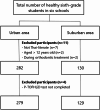Oral health literacy: its impact on oral health outcomes and associated factors in sixth-grade primary school students - a cross-sectional study
- PMID: 40775320
- PMCID: PMC12329877
- DOI: 10.1186/s12903-025-06613-y
Oral health literacy: its impact on oral health outcomes and associated factors in sixth-grade primary school students - a cross-sectional study
Abstract
Background: Low oral health literacy (OHL) plays a crucial role in contributing to poor oral health outcomes. However, limited studies have focused on school-age children. This study aims to investigate the association between OHL among sixth-grade primary school students and oral health outcomes, and to identify factors related to inadequate OHL.
Methods: A cross-sectional study was conducted among 408 Thai sixth-grade primary school students (aged 12 years) in Pathum Thani Province, Thailand. Participants completed the Test of Functional Health Literacy in Dentistry for Primary School Children (P-TOFHLiD) to assess OHL and underwent oral examinations. Oral health behaviors were collected through participant interviews and caregiver questionnaires, while demographic data were obtained from caregiver questionnaires. Chi-square tests, Spearman's correlation, and logistic regression were used to assess associations between OHL and oral health outcomes, and to identify risk factors for inadequate OHL.
Results: The mean P-TOFHLiD score was 19.4 (SD = 4.7), with a median of 21 (IQR: 17-23). 59.6% had inadequate OHL (score < 21). Chi-square tests showed that participants with inadequate OHL were more likely to have untreated caries in permanent teeth (p < 0.001), first permanent molars with disease-related pulp exposure (p = 0.001), poorer oral hygiene (p < 0.001), and consumption of cariogenic snacks (p < 0.001), while no associations were found with missing or filled permanent teeth, brushing frequency, fluoridated toothpaste use, or dental service utilization. Logistic regression showed that inadequate OHL increased the odds of having untreated caries in permanent teeth (AOR = 8.30, 95% CI: 4.89-14.11), first permanent molars with disease-related pulp exposure (AOR = 20.63, 95% CI: 4.84-87.91), and poor oral hygiene (AOR = 2.08, 95% CI: 1.20-3.59). Lower Grade Point Average (GPA) (AOR = 0.01, 95% CI: 0.00-0.02) and low family income (< 10,000 Baht) (AOR = 3.56, 95% CI: 1.62-7.82) were associated with increased risk of inadequate OHL.
Conclusions: Inadequate OHL was linked to adverse oral health outcomes. Lower GPA and low family income were identified as risk factors for inadequate OHL. These findings emphasize the need for targeted interventions to strengthen OHL and improve children's oral health.
Trial registration: Not applicable.
Keywords: Dental caries; Oral health literacy; Oral health promotion in school; Oral health status; P-TOFHLiD; Primary school-aged children; TOFHLiD.
© 2025. The Author(s).
Conflict of interest statement
Declarations. Ethics approval and consent to participate: This study was approved by the Human Research Ethics Committee of Thammasat University (Science), Thailand (HREC-TU COA No. 027/2567), which considered the protocol in accordance with the Declaration of Helsinki, the Belmont Report, CIOMS guidelines, and international practice (ICH-GCP). Informed consent was obtained from all participants and their primary caregivers. Consent for publication: Not applicable. Competing interests: The authors declare no competing interests.
Figures
Similar articles
-
Topical fluoride as a cause of dental fluorosis in children.Cochrane Database Syst Rev. 2024 Jun 20;6(6):CD007693. doi: 10.1002/14651858.CD007693.pub3. Cochrane Database Syst Rev. 2024. PMID: 38899538 Free PMC article.
-
Facilitators of Oral Health Literacy and Predictor of Oral Health Outcomes in Adult Population of Ahmedabad City, India.Niger Postgrad Med J. 2025 Jul 1;32(3):171-177. doi: 10.4103/npmj.npmj_15_25. Epub 2025 Aug 1. Niger Postgrad Med J. 2025. PMID: 40745872
-
WITHDRAWN: Community-based population-level interventions for promoting child oral health.Cochrane Database Syst Rev. 2016 Dec 22;12(12):CD009837. doi: 10.1002/14651858.CD009837.pub3. Cochrane Database Syst Rev. 2016. PMID: 28004389 Free PMC article.
-
Role of oral health literacy in demand for oral healthcare services for missing teeth replacement among dental patients visiting a dental teaching hospital in India.J Indian Prosthodont Soc. 2025 Jan 1;25(1):59-66. doi: 10.4103/jips.jips_283_24. Epub 2025 Jan 3. J Indian Prosthodont Soc. 2025. PMID: 39750010 Free PMC article.
-
Primary school-based behavioural interventions for preventing caries.Cochrane Database Syst Rev. 2013 May 31;2013(5):CD009378. doi: 10.1002/14651858.CD009378.pub2. Cochrane Database Syst Rev. 2013. PMID: 23728691 Free PMC article.
References
-
- Thai Bureau of Dental Health. The 9th National Oral Health Survey in Thailand. Department of Health, Ministry of Public Health. 2024. https://dental.anamai.moph.go.th/th/national-oral-health-survey-report/4952. Accessed 14 Jun 2024.
-
- Krisdapong S, Sheiham A, Tsakos G. Oral health-related quality of life of 12- and 15-year-old Thai children: findings from a National survey. Community Dent Oral Epidemiol. 2009;37(6):509–17. - PubMed
-
- Thai Bureau of Dental Health. Draft Thailand National Oral Health Plan 2023–2037. Department of Health, Ministry of Public Health. 2024. https://dental.anamai.moph.go.th/th/oral-health-plan/download?id=115982%.... Accessed 14 August 2024.
MeSH terms
Grants and funding
LinkOut - more resources
Full Text Sources
Medical


